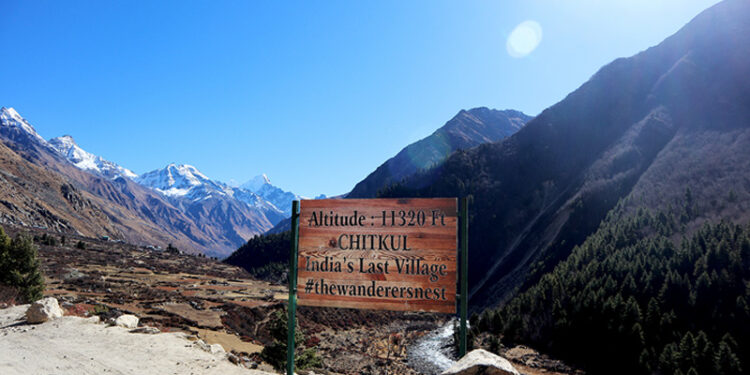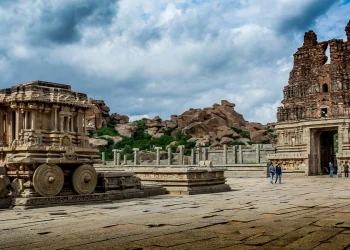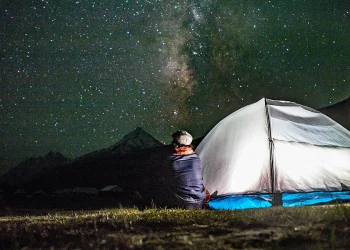By Swapnil S. Bhole & Neha Raje
Chitkul, a hidden hamlet with its own peculiar beauty, lies in the region close to the Indo-Tibetan border. Roads leading to the village and the scenery on the way are almost spectacular.
Appropriately called “The Last Village of India”, Chitkul lies in Kinnaur district of the state of Himachal Pradesh. Situated along the river Baspa, it is the first village of Baspa valley and the final village on old Hindustan-Tibet road. Your trip to Himachal is unquestionably incomplete without a visit to Chitkul.
In Chitkul, one wakes up to the crystal clear blue skies and birds chirping. A perfect evening can be spent by drinking a hot cup of chai or coffee and gazing at the gripping sunset post an afternoon nap.
During the day one can spend time by being part of the local community, and helping them with their daily activities.
The sound of bells ringing in the temples, adding to the mystical calmness of this place transforms Chitkul into an abode of Mountain Gods. It is also the last place in India, where one can travel without any permit.

Home to around 600 to 650 habitants, Chitkul is surrounded by snow capped Himalayas from the three sides and the Baspa River flowing across. It is very difficult to define the beauty of Chitkul in words, but one only has to experience it to feel it.

Sharp edges of the rocks, just softened by the snow, rising above as if to tear the skies, construct some of the most astonishing landscapes on mother Earth. Perhaps the world’s oldest and the grandest mountain system “The Himalayas” rest on India’s forehead and have given the state of Himachal Pradesh its nucleus. This is exactly what one gets to experience while visiting Chitkul.

The road to Chitkul deviates from old Hindustan-Tibet Road (NH 22) at Karchham town, from where Chitkul is roughly at a distance of 39 kilometres. Enroute to Chitkul one passes through few villages like Sangla, Batseri and Rakchham. The road ends at Chitkul making it the last inhabited village on the Indo – China border.

Like many other regions, every village is Kinnaur district has its own local devata and Chitkul’s local deity is Mathi Devi. There are three temples dedicated to Mathi Devi in the village. It is believed that, the Goddess had made a tough expedition from Vrindavan to reach Chitkul while travelling to Mathura and Badrinath in between, with her family.
After deploying her nephews and husband as guards of various regions in Himachal Pradesh, the Devi finally decided to settle in Chitkul. It is believed that after her arrival, the village started to flourish and this made her an important deity here.
According to the legends, the presiding deity of the adjoining village of Kamru, Lord Badrinath is her husband and the Nag Devta of Sangla and Shamshare Devta of Rakchham are her nephews.

The history of Kinnaur is preserved in a very unique way through its verbal tradition. The generations of Gorkchs, the traditional local oracles, specialize in reciting historical narratives.
The performances of the Gorkchs during festivals are a celebration of the culture through oral history preserved by these bards. These performances include local history as well as the recitation of the myths of the presiding deities of the villages.
The best way to explore Chitkul is on foot. Going through all the nooks and corners of the village is an experience in itself.
Chitkul has a typical clustered hillside village pattern, with narrow, steep and meandering footpaths, connecting each household and public place acting as the main village thoroughfares. Recently some pathways are made of concrete or stone, while few pathways are of mud or grass, just broad enough for one person to walk.

The first thing that attracts as you enter the village is the Fort Chitkul, which stands tall in the overall village huddle. It is a three-storied tower structure typically built in traditional hilly architecture. Base is solid, made of locally available stone on which the super structure stands.
Upper three stories are made of alternating layers of stone and wood. The Devata rests on the topmost floor, surrounded by cantilever wooden balconies on three sides. Apart from the local villagers, no one is allowed to enter it. At present this amazing structure lies in a very poor state.
Another thing that seeks one’s attention in the village is the temple of Mathi Devi. As per locals, the temple is about 500 years old and Mathi Devi is the local deity.
The Mathi Devi temple is indeed an architectural gem. Recently it has been restored, hence the earlier wooden roofs have been replaced by stone. Constructed out of wood and stones, the temple is a perfect example of the unique Pahadi architecture. It’s a temple complex, with intricately carved wooden carvings and a distinctive roof profile. The temple stands in the middle of the village with all its grandeur.
The most iconic facet of the Chitkul village is its old timber houses. These houses stand out to be a spectacular epitome of vernacular style of architecture. One just has to walk around the village seeing these houses and meeting the inhabitants.

Walking on the footpaths through Chitkul, one sees a vast variety of style in the vernacular houses. No two are the same in scale or detail and the houses are very close together. They orient in different directions in relation to the road, pathway and slope.
A lot of houses take benefit of the sun and the view of the peaks by having their front face towards them. But due to the stiff clustering and steep topography, exceptions are always there.
Construction materials vary, as well as the basic house form. Predominantly stone and wood were used as the common traditional materials, but new homes often use concrete.

Originally, the roofs were covered by wood, then replaced by local stone and now people have started using Tin sheets. With all of this multiplicity however, one can still gather an essential Kinnauri vernacular style architecture.
Changes are noticeable in these vernacular houses, but lot of similarities still remain, helping the traditional landscape hold on to the character of the place that reflects a distant past in the middle of a modernizing society. They seem to have kept their old traditions alive.

The road leading to Chitkul is usually closed between November to March as heavy snowfall makes the road difficult to drive on.

Travelling to Chitkul is no less than a daredevil act as one has to pass through one of the world’s most dangerous roads of Kinnaur district, which are extremely steep, narrow and rough. Visiting Chitkul can promise, in its own unique way, to provide travellers with little joys of life which one misses in the cities.
One can never have enough of exploring Chitkul village, getting associated with the locals, mingling with curious children, enjoying natural vistas in the mystic place with birds twittering all around you. Chitkul is a place where time seems to have come to a halt. This little beautiful land of the Gods still retains its original and unique character.
“NEVER GAUGE THE SPAN OF THE ROAD UNTIL ONE RECAHES THERE. ONLY THEN YOU WILL SEE HOW CLOSE THE DESTINATION WAS” Swapnil S. Bhole.
TRAVEL INFO
How to Reach:
By Air: Shimla Airport in Jubbarhatti (263 km) is the nearest airport. Chandigarh Airport (360 km) is the nearest major international airport.
By Train: Shimla Railway Station (245 km) is the nearest railway station.
By Road: From Shimla to Chitkul, the distance is 245 kms.
From Delhi to Chitkul, the distance is 603 kms.
Accommodation: There are many resorts and hotels in Chitkul where you can spend a relaxing holiday.
Best Time to Visit: April to October.

Founded in 2016, The Traveller Trails is a print and digital magazine and a trusted source for current news, trends, analysis, opinions, interesting blogs, videos and exclusive interviews from every corner of the world.












